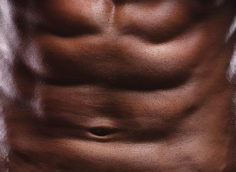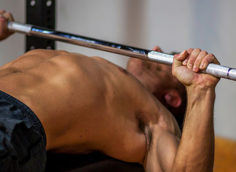The lead photo is Chris Dickerson, who won the 1970 AAU Mr. America and the 1982 Mr. Olympia, had the best calves I've ever seen on a bodybuilder. Much of Dickerson's calf width was a result of the inherited length of his gastrocnemius and soleus muscles.
Get ready to learn about the most productive calf routine that I've ever used. Most of this old-school cycle was the creation of Jim McLellan of Denver, Colorado. I used McLellan's calf routine multiple times in the 1970s and eventually added a few revisions of my own. The end result is a cycle that combines some of the techniques of super sets, rest-pause, burns, and the negative-accentuated style.
If you have stubborn calves, calves that refuse to grow, then, this is the perfect program for you. The two-week routine penetrates to your deepest contractile tissues, engorges, inflames, stimulates, and produces greater size you've been looking for.
Soreness? Yeah... deep, as well as surface, especially during the first week. But the soreness dissipates during Week 2.
Equipment: A standing calf-raise machine, or something similar, such as a barbell inside a power rack. If the calf machine or power-rack assembly doesn't incorporate a high ledge to stand on to perform the calf raises, you'll need a 4-inch block of wood secured to a larger board to prevent it from tipping or turning, along with rubber-soled shoes.
Trying to rig up something with a barbell, dumbbell, and a thick phone book or a 2 x 6-inch board to stand on WON'T WORK. You must be able to balance yourself securely during the many phases of this extended calf set. You absolutely must have access to a standing calf raise machine, or a power rack combined with a barbell and a stable block of wood.
Below is a description of the movements that make up Weeks 1 and 2. The directions may seem complex. Read them several times carefully until you understand the details.
The first seven guidelines relate to ONE extended set of calf raises. Once you start the extended set, you remain in the machine for 3-4 minutes.
- Select a resistance that permits 15 full-range repetitions on the standing calf raise. (I suggest that you select approximately 20-percent less resistance than you normally use.) Position your feet shoulder-width apart and parallel to each other. Do your repetitions in very strict form: up on your toes as high as possible – until the muscle almost cramps – then down slowly into a deep stretch. Keep your knees stiff, but not locked. Do not hurry these movements
. . . focus intensely on each one. - Stand on one foot, while still in the machine, and lift the other foot and shake it to help relax the calf. Do the same for the other foot. Then, back to the first, and back to the second. The rest-relax cycle involves two quick shakes for each calf, and once you get the hang of it, all the shakes should take only 6 seconds.
- Stand again on both feet and do 8 more repetitions of the calf raise; then another round of rest-relax shakes just like before.
- Do 8 more repetitions and the same shakes.
- Do a final set of 8 repetitions, but NO shakes. Immediately, with no rest, go into the "burns" stage.
- Perform short-range movements, burns, in the contracted position for as long as you can stand it . . . usually 15 to 20 seconds. Then, there's a last phase.
- Go up on both calves and while in the top position, take one foot off the block and slowly lower with the other foot/calf only. This style, up with two limbs and down with one, is called negative-accentuated. Continue for 5 to 10 repetitions of each leg, depending on what you can tolerate. This concludes one extended set, so you can ease out of the machine.
- Sit and massage your extremely pumped calves for exactly 2 minutes. (I've never, in my 50 years of bodybuilding, experienced a pump like this extended set produces.)
- Stand, step up on the stable block of wood, and do the one-legged calf raise in the following manner: Work your smaller calf first. Balance yourself on 1 leg with no resistance other than your body weight. Raise your heel as high as possible. Attempt to go higher by standing on your big toe. Lower your heel slowly to the stretched position. Try to go lower by extending and spreading your toes. Continue for 15 slow, smooth repetitions. Do the same number of repetitions for the other calf.
- Repeat for three, non-consecutive days for Week 1.
Review
The calf cycle consists of 15 reps, 2 shakes; 8 reps, 2 shakes; 8 reps, 2 shakes; 8 reps, no shakes; immediately into short-range burns for 15-20 seconds; followed by negative-accentuated, 2-up/1-down for 5-10 reps. Rest and massage calves for 2 minutes. Do the 1-legged calf raise for each leg for 15 reps.
During Week 2, you'll drop the 1-legged calf raise and add a second set of the 15-8-8-8-burns-negative-accentuated routine. Here are the instructions for Week 2:
- Add 5 percent more resistance to the calf raise machine.
- Stand and do 15 strict reps in the calf raise. Then perform the 2 shakes and 8 reps three times, followed by burns, and negative-accentuated reps.
- Rest and massage your calves for exactly 2 minutes.
- Stand and do the calf cycle a second time, from beginning to end, with the same resistance. It's okay to move a little faster during the second cycle.
- Repeat for three, non-consecutive days for Weeks 2.





